- The Inventory

A Brief Guide to Star Trek: Discovery 's Big Timey-Wimey Twist This Week
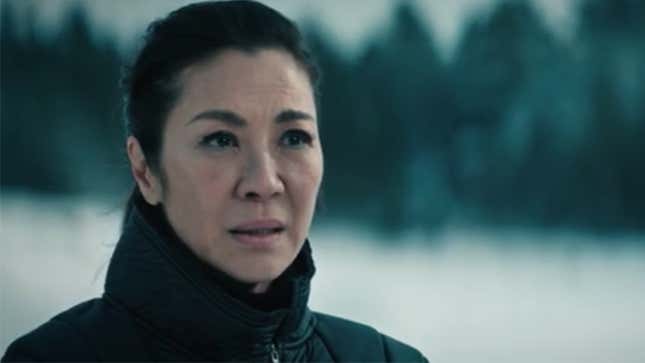
An emotional powerhouse on Star Trek: Discovery this week laid the groundwork for some big future events in the franchise. It just happened to do so with the help of a classic piece of franchise iconography in the process
Related Content

“Terra Firma, Part 2” resolves Emperor Georgiou’s arc on Discovery this season. Her body had been slowly breaking down from dimensional and temporal displacement thanks to traveling from not just her own reality but nearly a thousand years into the future. It threatened to violently tear her apart but also managed to give the character a way out that didn’t end in, well, violently tearing her apart .
After being tested with how much she’s grown as a person since she was brought over to Star Trek ’s prime reality, Georgiou was given a chance by a strange, omnipotent being presenting himself as a fancy bowler-hatted man named Carl. She passed his tests, and now she can travel back in time to a period where the Prime and Mirror realities were cosmically closer together, putting her body back into a stable state, but cutting her off from the people she had learned to care about aboard Discovery .
Carl did all this by revealing his true nature: he wasn’t just any one of Star Trek ’s latinum-strip-a-dozen godlike beings—he’s the Guardian of Forever . To put it more plainly, they’re a great big ol’ time-space door that, today, made its third appearance in the franchise for the first time in 47 years since The Animated Series ’ “Yesteryear.”
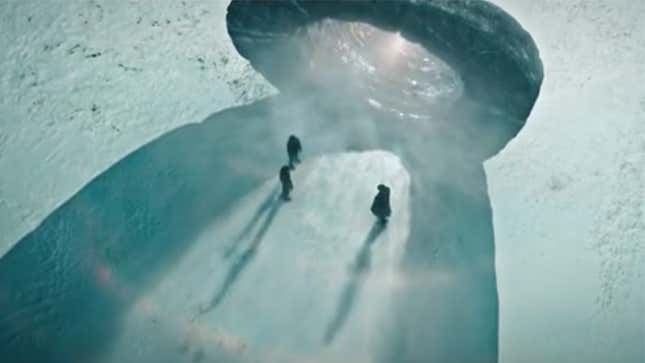
If you don’t remember just who the Guardian of Forever is, the oddly-shaped portal/stone gateway first appeared in one of the most iconic episodes of the original Star Trek : Harlan Ellison’s “The City on the Edge of Forever.” It’s the omnipotent being that Kirk, Spock, and McCoy found after the latter went a bit doolally on an overdose of Cordrazine, beaming himself down to a mysterious planet the Enterprise was investigating for some temporal anomalies. Those anomalies were caused by the Guardian of Forever, an ancient entity that sat at the nexus of all timelines in the Milky Way.
The construct of an ancient, forgotten race, the Guardian was a gateway to any point in time and space, and a sentient being despite being a construct. It could telepathically communicate with people, respond to external stimuli, and also send them through a gateway to any known point in history. The Extremely High Dr. McCoy flung himself into 1930s New York and accidentally altered the course of Starfleet’s history, necessitating Spock and Kirk to go on an ultimately heart-breaking mission to the period to rescue their friend and the present as they knew it.
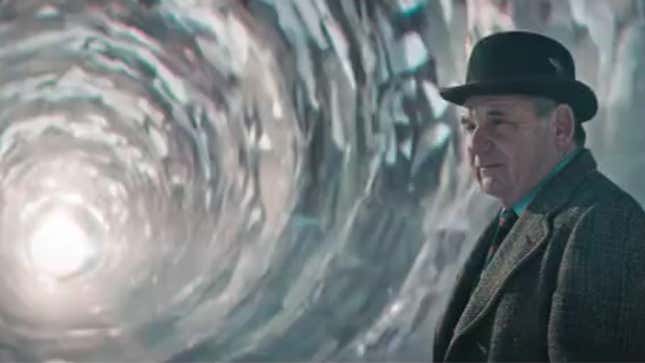
So what’s the Guardian of Forever now doing 922 years in the future on an entirely different planet? This time, “Carl” is hidden away when Georgiou and Michael encounter them on Dannus V, an icy planet just outside the Gamma Quadrant. And there aren’t multiple Guardians of Forever, it turns out. As Carl explains, they’re a product of another piece of Trek history, this time from more recent shows: Star Trek: Enterprise ’s Temporal War.
A cold war fought between Temporal Powers, including the Federation and a faction known as the Na’kuhl, the Temporal War turned hot in a now-alternate 29th Century. The Na’kuhl disavowed the Temporal Accords agreed to by all other time-travel-capable societies to limit the manipulation of time. Attempting to gain power over the universe, they plundered history creating paradoxes and changing timelines until a coalition of forces—helped in part by Captain Archer and the mysterious Daniels—defeated Vosk, the Na’kuhl leader before he could turn the cold war into an even more devastating conflict. It’s from here that new accords were signed forbidding time-travel outright, leading to Admiral Vance’s skepticism of Discovery when he first learned the ship had reached the 32nd Century through time-travel, albeit from a time before the accords were written.
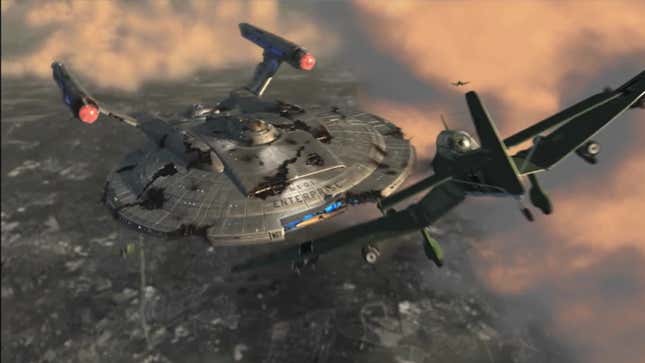
Which brings us to “Carl”—the Guardian of Forever, sensing the disruptions to time that Vosk’s conflict caused, decided to relocate onto a new planet away from prying eyes, after multiple factions in the Temporal War attempted to use their abilities for evil. This is why, it turns out, it puts on the guise of a quaint human with a taste for fetching headgear.
It might have only been to lay the groundwork for Georgiou’s exit into her own Section 31-themed spinoff , but it was still a cool way to interweave two time-themed elements of Star Trek ’s past into its new, far-flung future.
For more, make sure you’re following us on our Instagram @ io9dotcom .
Advertisement
- Cast & crew
- User reviews

The City on the Edge of Forever
- When a temporarily insane Dr. McCoy accidentally changes history and destroys his time, Kirk and Spock follow him to prevent the disaster, but the price to do so is high.
- When an accident causes Dr. McCoy to go temporarily insane, he escapes to a strange planet. There, the search party discovers a device left by a superior, vanished civilization, a time portal that plays the history of Earth for them - but then Bones jumps through it into the past, causing a change in history important enough to make the Enterprise vanish. Kirk and Spock, who fortunately made a tricorder recording, must attempt to go through to just before McCoy's arrival and stop him from changing history in the United States during the Great Depression, where they have no advanced technology available. — KGF Vissers
- After being accidentally injected with a powerful drug, Dr McCoy flees the Enterprise in a hysterical state and beams down to the desolate planet the ship has been orbiting. Searching for McCoy, Captain Kirk and his landing party discover a mysterious time vortex through which the good doctor has escaped. — FilmsNow
- When a drug-crazed Dr. McCoy leaps through a time portal to 1930 Earth, he does something to change history resulting in the disappearance of the Enterprise. Kirk and Spock soon follow hoping to arrive just before McCoy. They soon find themselves working at the 21st Street Mission for the beautiful Edith Keeler. Spock builds a crude computer and finds two newspaper articles about Edith: one dated 1936 about a meeting she had with President Roosevelt and the other her obituary dated 1930. The question then becomes which of the two are correct. Is Edith Keeler, with whom Kirk has fallen in love, supposed to live or to die? — garykmcd
- The Enterprise passes a planet which sends out shock waves (caused by changes in the space time continuum.. something on the planet has the ability to change time). Sulu is badly hurt at his helm station, McCoy prepares to administer an important drug called Cordrazine. "A few drops can save your life." says McCoy. Just then, another shock wave hits, and McCoy accidentally injects the drug into his own arm (the entire hypo-spray). McCoy has become a madman, and is running around like crazy. He punches a guard, and beams himself down to the planet. Of course, they must try to rescue him. Kirk, Spock, Scott, Uhura and two red-shirts (security) beam down after him. When they arrive on the rocky planet, they see a large arched gateway with shimmering rocks. There are rocks all around, and McCoy is hiding behind one. Spock gives him a neck pinch to put him temporarily to sleep. The arch speaks in a dark, forbidding voice. "A QUESTION!! SINCE BEFORE YOUR SUN BURNED HOT I HAVE AWAITED A QUESTION." The arch then 'says' that it is the Guardian of Forever. It displays scenes from world history within the semi-circle of its arch, ranging from Egypt, to Palestine, to Rome, to modern day, and keeps showing them in a loop. "The Guardian" says they can travel to anywhere in the past they wish. Spock (finally) turns on his tri-corder. Uhura is in contact with the ship (to prepare for when they need to beam up). McCoy wakes up, pushes the two guards aside, jumps into the arch, and vanishes. Uhura says "Captain, I've lost contact with the ship." They all check their communicators, and have nothing but dead air. The Guardian says slowly, "All that you knew is gone." Kirk is confused. Spock theorizes that McCoy must have changed history, when he arrived in the past. Now they must rescue him. Only Kirk and Spock will go to find the solution and rescue McCoy and the Universe. Kirk says "If we fail to correct the damage McCoy did, all of you must jump in. You will be alive at least in the past. Uhura says "Captain, I'm scared". Kirk comforts her. Spock times the 'jump' with his tri-corder and they both jump in. They are back in 1930's Earth in New York, during the Great Depression of the 1930's. Everyone is poor. They steal some earth clothes to 'hide out' and duck into a basement running from a cop. Someone asks from the top of the stairs "Who is there?" They say "We just wanted to get warm." The woman coming down the stairs is beautiful, like an angel. She is a social worker with big ideas, very, very pretty, and Kirk is attracted to her. She gives Kirk and Spock a job at 15 cents an hour, and Spock tries to build a computer using copper wire and other cheap material. He says to Kirk "You are asking me to assemble a mini computer using the equivalent of stone knives and bearskins." Spock explains that they cannot determine whether McCoy arrived before or after their 'jump.' But during the time before McCoy comes, Kirk is falling in love with Edith Keeler (Joan Collins). Spock finally assembles enough data to examine newspaper articles from the time to show the two different time-lines that would occur, and that Mccoy somehow changed. It turns out that the focal point is Edith Keeler. In the first time-line, Edith becomes the head of a peace movement that grows to such size that it stalls the US entry into WWII, but when she did, she unwittingly let Nazi Germany take over the world. But in the other, she is struck by a truck that very week. Spock concludes that for the Universe to be set right, Edith Keeler must die. Kirk says to Spock "Spock I believe I am falling in love with Edith Keeler. Spock says "Jim, in order for the Universe to be saved, we need to stop McCoy from somehow saving her. Edith Keeler must die as it actually happened." McCoy lands on the street in the middle of the night, and is still woozy from the Cordrazine. He loses his phaser pistol and a bum picks it up and accidentally phasers himself to disintegration. The next night Kirk is taking Edith to the movies. Edith says "I have been dying to see the latest Clark Gable movie. "Who?" asks Kirk. Edith says "You know Doctor McCoy said the same thing today" (McCoy had walked into Edith's mission on 21st street for a cup of coffee). Kirk says "Who?? Where?" "He's in the mission, she says. "Wait here" says Kirk. He runs across the street to the Mission. McCoy runs out and Spock too. They're reunited. Then Edith starts to cross the street. Kirk looks and sees a big truck coming. He begins to go after her. Spock says "No, Jim." Then McCoy jumps toward Edith, and Kirk grabs him, and holds him back. The truck kills Edith. She is dead. McCoy looks with horror at Kirk. "Do you realize what you just did, Jim?" Spock says calmly, "He knows, Doctor, he knows." They are returned by the Guardian to the planet.
Contribute to this page

- See more gaps
- Learn more about contributing
More from this title
More to explore.

Recently viewed
Time Portals
- View history
Time Portals are unstable openings between alternate and parallel dimensions. Through these Time Portals, characters across every time and dimension of the Star Trek Multiverse have converged within Star Trek Timelines .
Time Portals--as an item--are single-use and can be purchased for Credits and Dilithium , or obtained from Daily Rewards . "Opening" a Time Portal rewards the Captain with an Item or Crew member.
Basic Portals
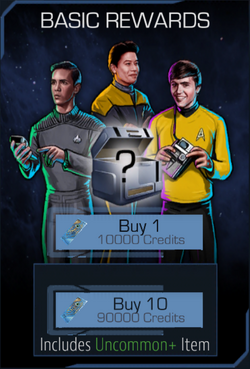
Single Gain 1 item or Crew of Basic or Common Rarity.
Pack of 10 Gain 10 items and/or Crew, at least one reward will be Uncommon or better.
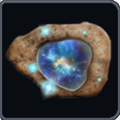
Premium Portals
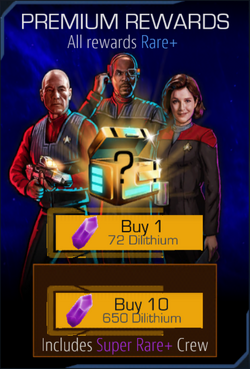
Single Gain 1 item or Crew of Rare or better Rarity.
Pack of 10 Gain a ★★★★ Crew, plus 9 items and/or Crew.
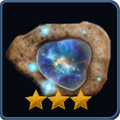
An example of a Behold! choice.
On rare occasions, a Crew result from a Premium Time Portal will offer the Captain a choice of three Crew members. The stats of each Crew can be viewed by tap-and-holding on each Crew.
Promotional Portals
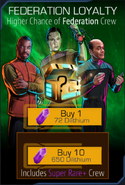
- ↑ Best of the Best only rewards Crew. A single pull from this Pack is the same price as 10 Premium Portals, awarding just the ★★★★ Crew without the other 9 randomly selected rewards. Crew may be duplicated in the 10-pack.
- ↑ Elusive Treasures only awards Crew. A single pull from this Pack is the same price as 10 Premium Portals, awarding just the Crew without the other 9 randomly selected rewards. Crew may be duplicated in the 10-pack.
- 1 Star Trek Timelines
- 2 Ex Astris, Scientia
Memory Beta, non-canon Star Trek Wiki
A friendly reminder regarding spoilers ! At present the expanded Trek universe is in a period of major upheaval with the continuations of Discovery and Prodigy , the advent of new eras in gaming with the Star Trek Adventures RPG , Star Trek: Infinite and Star Trek Online , as well as other post-57th Anniversary publications such as the ongoing IDW Star Trek comic and spin-off Star Trek: Defiant . Therefore, please be courteous to other users who may not be aware of current developments by using the {{ spoiler }}, {{ spoilers }} OR {{ majorspoiler }} tags when adding new information from sources less than six months old (even if it is minor info). Also, please do not include details in the summary bar when editing pages and do not anticipate making additions relating to sources not yet in release. THANK YOU
- Memory Beta articles sourced from Star Trek Online
- Memory Beta articles sourced from novels
- Time travel
Time portal
- View history
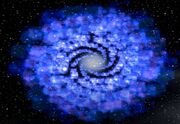
A temporal gate in 2376 .
A time portal [1] , also known as temporal portal [2] , temporal corridor [3] , and temporal gate [4] , was a portal for instantaneous movement from one point of the timestream or worldline to another. Traversing a temporal portal was a form of time travel . Temporal portals could be generated artificially, requiring advanced technology to accomplish. ( ENT episode : " Stormfront "; STO - Future Proof mission : " The Temporal Front "; ST video game : Armada )
History and specifications [ ]
Created in ancient times, the Guardian of Forever on planet Rock of Ages was a sentient time portal. ( TOS episode : " The City on the Edge of Forever ")
In the 2370s decade , Starfleet encountered a time portal on Golana . ( DS9 episode : " Time's Orphan ")
The Federation Department of Temporal Investigations considered the abandoned, easily accessible time portals of the Golanans a threat to the temporal integrity of the prime universe timeline. ( DTI novel : Watching the Clock )

USS Premonition opens a time portal.
In an alternate timeline where the Borg Collective had assimilated the majority of the Federation during the Borg Invasion of 2376 , the Premonition -class prototype timeship USS Premonition traveled through time using temporal gates generated by its temporal drive . Captain Thaddius Deming used the temporal drive to alter the course of the invasion, leading to a Federation Alliance victory over Locutus of Borg . ( ST video game : Armada )
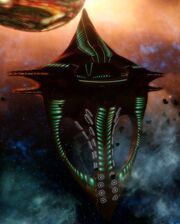
A temporal facility .
In the 29th century , General Vosk and his Na'kuhl radicals had to construct a temporal facility to generate a temporal corridor. Vosk and his people used one such corridor in 2883 to travel to an alternate Earth in 1944 . ( STO - Future Proof mission : " The Temporal Front ")
Once there, they used local technology to build another such facility in New York City . ( ENT episode : " Storm Front ")
From the 27th [5] to the 31st century , the Federation 's Temporal Integrity Commission [6] and the Federation Temporal Agency [7] used temporal portals to move themselves, and other targets, through time and space . ( ST performance: Star Trek Live , STO - Future Proof missions : " Time and Tide ", " Vorgon Conclusions ")
Appendices [ ]
References [ ].
- ↑ TOS episode : " The City on the Edge of Forever "
- ↑ STO - Future Proof mission : " Vorgon Conclusions "
- ↑ STO - Future Proof mission : " The Temporal Front "
- ↑ ST video game : Armada
- ↑ ST performance: Star Trek Live
- ↑ STO - Future Proof mission : " Time and Tide "
- 1 Ferengi Rules of Acquisition
- 2 The Chase
- 3 Preserver (race)
The Unexpected Resurrection of Harlan Ellison
Harlan Ellison died in 2018. Now, thanks to J. Michael Straczynski, he’s back. And louder than ever.
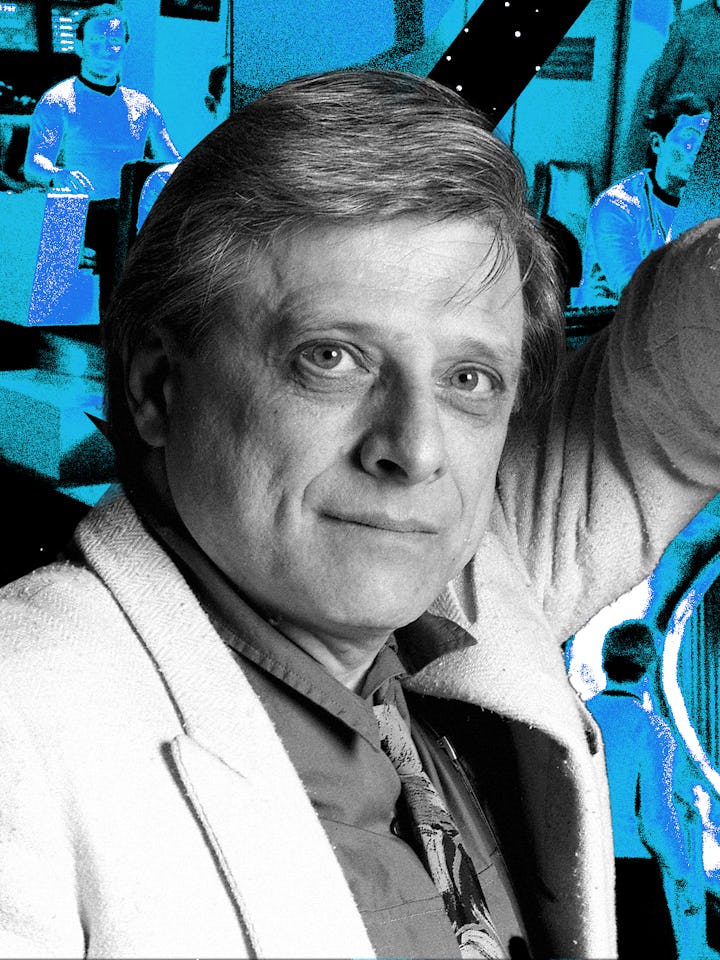
In 1968, a notoriously caustic science fiction writer accused Star Trek creator Gene Roddenberry of peddling “utopian bullshit.” In 1978, this same writer — in an introduction written for Doctor Who paperbacks — mocked Star Wars , decrying it as “adolescent nonsense.” In 1983, when he learned that James Cameron had admitted to “ripping off” one of his stories, he sued and got his name put in the end credits of The Terminator . In a 1979 interview in Starlog , Mark Hamill, baffled by this angry, impish contrarian, said: “I don’t want to get on a panel with Ellison… I thought he was like a game show host.” So who the hell was Harlan Ellison? And more importantly, why did he matter?
For generations of science fiction and fantasy aficionados, saying the name Harlan Ellison is like uttering a dark spell. Ellison’s writing — primarily in short story format — is fantastic and provocative, but his reputation for contentiousness was equally potent, often overshadowing the art itself. And for younger genre fans, the name Harlan Ellison might not mean anything at all. If you’re into science fiction and fantasy and came of age in the new millennium (and his 2014 Simpsons cameo went over your head), there’s a good chance you’ve never heard of Ellison.
“There was a time when he was one of the hottest speakers on college campuses anywhere, and now, he’s fallen between the cracks,” J. Michael Straczynski tells Inverse . “It was really important for me to introduce people to Harlan’s work again. A lot of his work just hasn’t been available for the past 10 or 20 years.”
Following Ellison’s death in 2018, Straczynski — comic book writing legend and creator of Babylon 5 — set out to reboot the legacy of the most energetic, and perhaps misunderstood, figure in all of speculative fiction. But this mission isn’t an attempt to sanitize or censor Ellison. Instead, with the release of a new book Greatest Hits (edited by Straczynski, with introductions from Neil Gaiman and Cassandra Khaw), Ellison’s specific brand of fantasy has re-emerged from those cracks, zombie warts and all.
The Leader of the New Wave
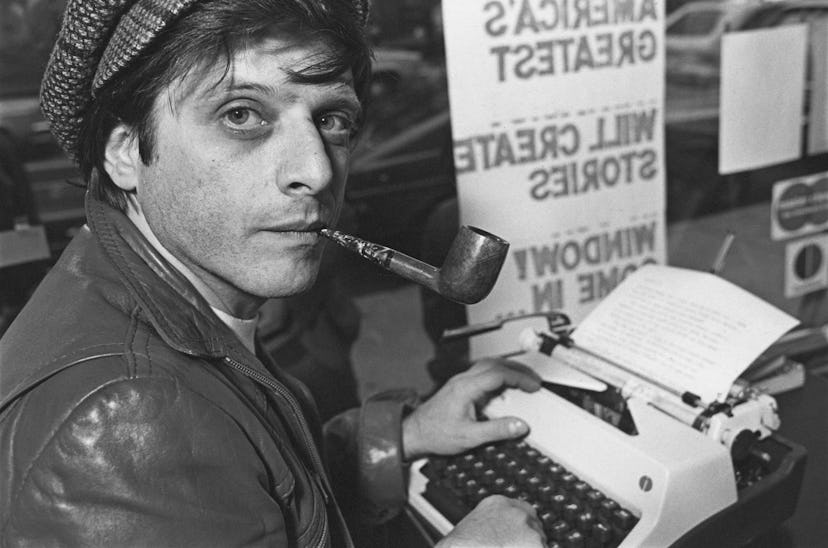
Harlan Ellison in 1977.
Harlan Ellison hated labels. Especially the label of “sci-fi writer.” In a 2013 profile written by Jaime Lowe for New York Magazine , Ellison said, “Call me a science-fiction writer and I will come to your house and nail your dog’s head to the coffee table!”
Part of his animosity stemmed from his tireless work to undo the genre stereotypes and constraints put on writers who worked outside of the mainstream. From the beginning of the 20th century up to the 1960s, the genre of science fiction was very different from what came next. A huge part of that change was the revolution of the “New Wave” of science fiction writers who pushed back against the stodgier and stuffier traditions of “Hard SF” and infused the genre with more literary and poetic sensibilities. Some started saying the written genre of “SF” stood for “speculative fiction,” not just science fiction. But without Ellison, science fiction (or speculative fiction) might never have grown up.
“What Harlan did in particular was to codify the New Wave,” Straczynski says. “With Dangerous Visions , he pulled it all together into one place and made it an event.”
Published in 1967, Dangerous Visions was a massive SF anthology of short stories, all edited and acquired by Ellison. (It’s just been republished, complete with a new introduction from Patton Oswalt. ) The goal was to give writers a home for short stories that were so extreme or taboo that even science fiction publications wouldn’t touch them. The first volume included edgy tales from Philip K. Dick, Robert Bloch, and J.G. Ballard, while the second volume, Again, Dangerous Visions , boasted classic short stories from the likes of Ursula K. Le Guin, Kurt Vonnegut, Joanna Russ, and Kate Wilhelm. As something of a trademark of Ellison, each story contained a lengthy introduction about the author, written in a rapid-fire, off-the-cuff style that would make Hunter S. Thompson blush. In his introduction to Dangerous Visions , Ellison brazenly declared : “What you hold in your hands is more than a book. If we’re lucky, it will be a revolution.” In a sense, he was right.
“There’s the whole thing about social movements,” Straczynski says. “Often, one person stands up and sort of embodies all of what they’re saying, and then it becomes a movement, and then it becomes a thing. And with Dangerous Visions and the New Wave, Harlan became that movement and that spearhead.”
But beyond bolstering the careers of others (he was Octavia Butler’s mentor and champion) Ellison’s own writing was unlike any other science fiction stories in the field. His two most famous stories, “Repent, Harlequin, Said the Ticktock Man” (1966) and “I Have No Mouth and I Must Scream” (1967), are simultaneously arresting and, for their time, extremely creative. In the first, a future society obsessed with time subtracts minutes from people’s lives when they are late or break the law. In the second, a sadistic AI keeps six human beings alive and tortures them to the ends of the Earth. But that’s just the tip of the dark matter iceberg that is Harlan Ellison.
“He pulled it all together into one place and made it an event.”
He pioneered stories about super-powered telepaths with his classic “Deeper Than Darkness” (1957) and touched on concepts of immortal, undying evil in “Mefisto in Onyx” (1993). When read today, his doppelganger story “Shatterday” (1977) feels like a condensed version of a David Lynch movie, combined with the parallel worlds antics of contemporary Apple TV shows like Constellation and Dark Matter .
But Ellison’s brand of dark speculative fiction wasn’t just limited to the page. He was also part of a growing trend in the 1950s and 1960s, in which authors of prose sci-fi began writing for TV. With thrilling episodes of The Man From U.N.C.L.E. and The Outer Limits , plus authorship of what is considered to be the best episode of the original Star Trek , Ellison was like a one-person Black Mirror . Indeed, one of his sci-fi horror stories, “Life Hutch,” was adapted as part of Love Death and Robots in 2021.
So with all of this success and brilliant output, why was Harlan Ellison so angry?
The Antichrist of Science Fiction
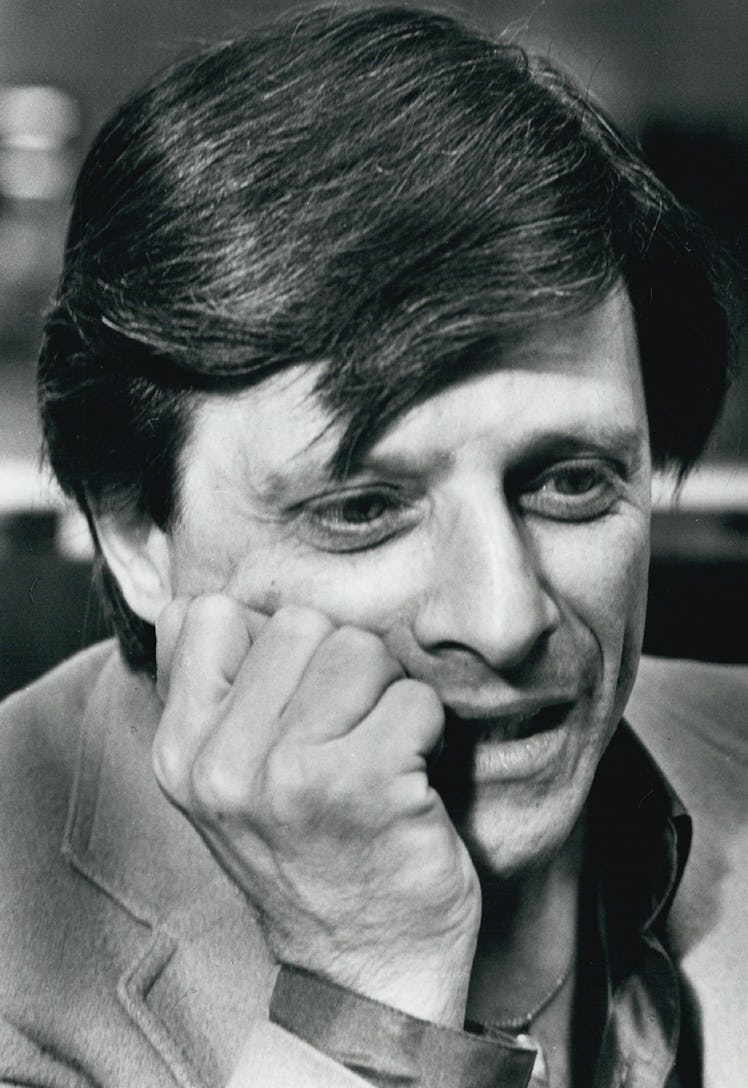
Writer Harlan Ellison at Mile High comics book store in 1982.
Harlan Ellison wrote Star Trek ’s seminal time-travel tragedy, the 1967 episode “The City on the Edge of Forever.” For almost six decades, this single story has often been cited as the best episode of Star Trek , ever, and its legacy continues to be relevant to the canon today — Michelle Yeoh’s upcoming Section 31 movie is a direct result of her character, Philippa Georgiou, stepping through the Guardian of Forever , a time portal originally introduced in Ellison’s episode.
Ellison infamously hated the aired version of the episode. While at least one entire book has been written about this kerfuffle, Ellison’s frustration basically comes down to a rowdy, and utterly divergent rewrite, which he said compromised his artistic integrity. Ellison felt steamrolled by Gene Roddenberry, which was ironic because just one year prior he’d formed “The Committee” — a select group of massive science fiction authors, including Frank Herbert , A.E. van Vogt, and others — with the express purpose of making sure Star Trek remained on the air.
“I think he just saw a lot of sloppiness going on [with Star Wars ].”
“What Star Trek really did was popularize science fiction in ways that hadn’t been done before,” Straczynski says. “It brought a new language in the vernacular to the popular culture. It galvanized the space program. There will never be another Star Trek any more than there’ll be another Beatles, and their place in the culture cannot be overestimated. The downside of that is that it codified a certain kind of storytelling in ways that limit other opportunities.”
Ellison clearly saw the rise of big franchises like Star Trek and Star Wars as a double-edged sword for the larger world of speculative fiction. Yes, it made SF more mainstream, but it was also reductive. So he went on the attack. In the humorous and raunchy story “How’s the Nightlife on Cissalda?” (1977), Ellison, still annoyed by his Star Trek experience, depicted a fictionalized version of William Shatner unsuccessfully trying to seduce an alien creature.
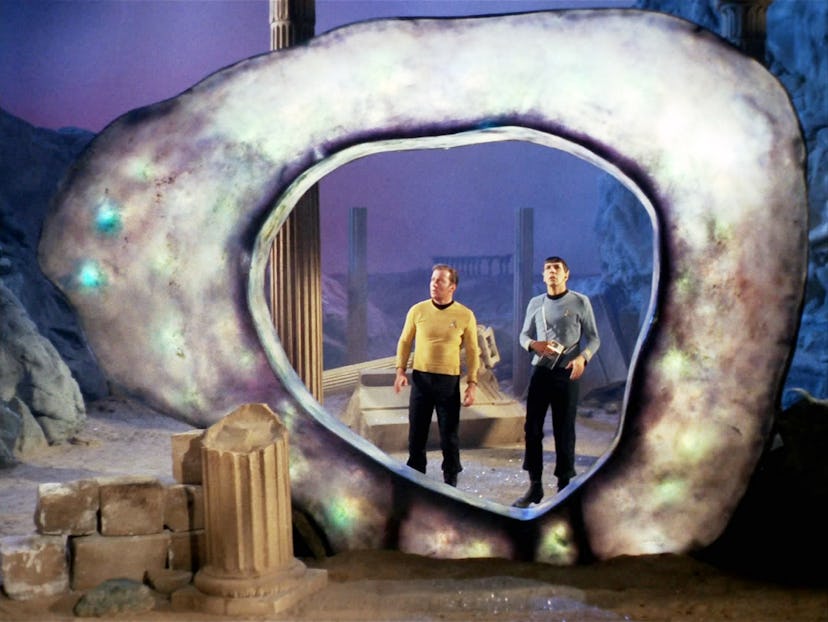
The classic Star Trek episode “City on the Edge of Forever.”
When it came to Trek , Harlan Ellison liked to bite the hand that fed him.
“He could dine off of ‘I wrote for Star Trek ’ for quite some time,” Straczynski says. “He was able to parlay that to success in many respects, even though he hated the process.”
While his anger over being rewritten explains some of his animosity with Star Trek — and its fans — why was Ellison so anti Star Wars ? As someone from the print world of science fiction who had tried to start a more progressive, literary trend in the genre, Ellison almost certainly saw the gee-whiz swashbuckling brand of Star Wars’ heroism as inherently regressive, more reminiscent of the conservative era of SF publishing in the ’30s and ’40s, than anything from what was then the modern era of speculative fiction.
“I think he just saw a lot of sloppiness going on [with Star Wars ],” Straczynski says. “Harlan was fairly rigorous in his writing, and there was just so much there that didn’t make sense.”
Ellison was hardly a voice in the wilderness on this topic: His friend and colleague Ursula K. Le Guin also trashed Star Wars in 1978, writing , “What is nostalgia doing in a science fiction movie?”
Because of his acerbic and often petty put-downs, Ellison behaved in public more like a bratty rock star than a writer. In a 1977 issue of Fantasy and Science Fiction , he even referred to himself as “the antichrist of science fiction.” In 1982, in the introduction for Ellison’s book Stalking the Nightmare , Stephen King acknowledged that not everyone was down with Ellison’s brand of iconoclasm but defended his artistic idealism, writing, “People who are afraid don’t like people who are brave.”
A Rebirth Before Death

Harlan Ellison and lifelong friend Walter Koenig (of Star Trek fame) at the Star Trek Las Vegas Convention in 2014. Ellison’s animosity toward Trekkies lightened up in the last years of his life.
Because he cared about human rights (and the often tramped-on rights of writers), Ellison didn’t make things easy on himself. As Straczynski writes in his introduction to Greatest Hits , it was “exhausting” to be Harlan Ellison.
But then, after 2006, following a surreal acceptance speech at the Hugo Awards, something unexpected happened: Harlan Ellison, publicly, appeared to repent for some of his bad behavior. He was no longer giving terse and angry interviews. He was apologizing. He allowed a documentarian to chronicle his life. He even lightened up on Trekkies. In 2014, with the full cooperation of the Star Trek licensing division, IDW Comics published Star Trek: Harlan Ellison’s City on the Edge of Forever, a five-part miniseries that presented Ellison’s original award-winning teleplay as an episode of the classic Trek. In the letters pages, Ellison even walked back long-held assertions about how his script was misinterpreted, admitting, among other things, that despite decades of complaining about other writers not knowing the difference between “runes” and “ruins,” it turns out no such confusion ever existed.
In 2011, I was asked to call Harlan Ellison, after having written a review of his short story, “How Interesting: A Tiny May.” Fearful of his litigious reputation (I had compared Ellison to the Gallagher brothers from Oasis in my essay), I dialed the number with trepidation. But it turned out that the angry old man had merely wanted to thank me, saying “I appreciate you taking the time to read my story and say something about it.”
So, what happened? Why did Ellison mellow out later in his life? While it’s a much longer tale — that Straczynski plans to tell in due course — let’s just say that the lighter, more ebullient side of Ellison was partially because of the influence of Straczynski himself. There’s a reason why Ellison chose Straczynski to take on his literary estate, and their friendship and trust for each other is part of why Ellison’s final years were ones of good humor and grace.
A Writer’s Writer
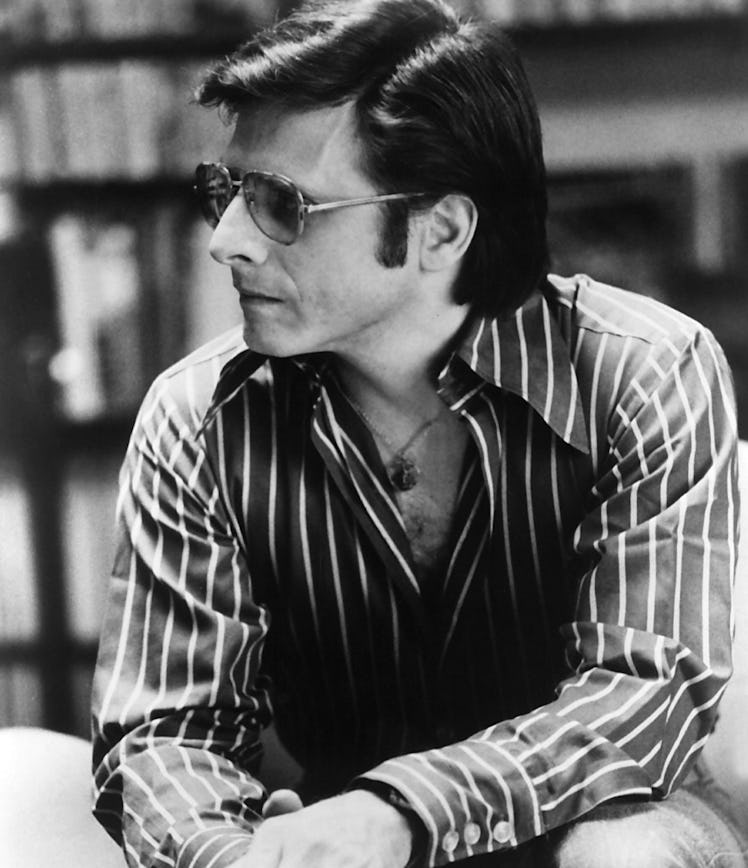
Harlan Ellison, around the time he edited Dangerous Visions in 1967.
Ellison disliked the pretension of writers and often insisted it shouldn’t be thought of as a “holy chore” but a job like any other. He often would sit in the windows of bookshops with his typewriter and write short stories based on prompts that were put in sealed envelopes ahead of time. In the final short story in Greatest Hits — “All the Lies That Are My Life” — Ellison makes a working-class distinction between an author and a writer . The former was someone who liked awards and prestige, the latter was “someone who gets hemorrhoids from sitting on his ass all his life… writing .”
This kind of attitude is probably best exemplified in his epic “Pay the Writer” rant , which highlights the ways in which the act of writing is so brutally devalued in the capitalist nightmare. Celebrated writer Patty Lin — the author of the recently published memoir End Credits: How I Broke Up With Hollywood — remembers Harlan Ellison’s staunch support of the rights of writers fondly. At the end of the 2007-08 Writers Guild of America strike, Lin recalls Ellison being furious that the WGA had capitulated too easily. Wearing “rumpled pajamas,” Lin says, Ellison chastised the union leadership for not going far enough. “We had them by the balls,” Lin remembers Ellison saying, depressed that the WGA didn’t get a better contact.
“It was that no-bullshit, justifiably angry way he expressed it that was so on brand.”
“I loved Harlan Ellison for what he said that day,” Lin tells Inverse . “It was exactly what I was thinking and what many other people in that room were probably thinking. It was that no-bullshit, justifiably angry way he expressed it that was so on brand. And that dramatic flair was what made him a great storyteller.”
As the title suggests, Greatest Hits is a kind of historical document. These are stories that don’t necessarily reflect where science fiction and fantasy are going but where the genre has been, as seen through the dark lenses of Harlan Ellison. Some of the stories (like “Shatterday”) hold up beautifully. Some, as Cassandra Khaw points out in her introduction, have problematic elements.
But unlike recent reissues of books by Roald Dahl or Ian Fleming , these stories remain uncensored. The fight against censorship was one of Ellison’s lifelong passions, and so, other than a few content warning labels in the book, the sex, sci-fi, and rock ’n’ roll of this writer's vision remains intact and raucous. Like the punk rock of genre fiction, Ellison’s stories are as jarring and blistering as ever.
“No, no, you don’t touch Harlan’s stuff, man,” Straczynski says. “Even if he’s dead, he’ll come after you.”
Harlan Ellison’s Greatest Hits is out now from Union Square and Co.

- Science Fiction
- More to Explore
- Series & Movies
Coming Soon
Blast, that page isn’t here yet. Return to the homepage or try a search .
If you think there should be something here, please reach out for support .

Star Trek: Discovery's Moll and L'ak Actors Say 'They're Not Really Villains'
Star Trek: Discovery Season 5 includes its feistiest and most unpredictable antagonists yet: the criminal duo of Moll (played by Eve Harlow) and L'ak (Elias Toufexis). Stealing a piece of Progenitor technology capable of reshaping the entire galaxy, Moll and L'ak are pursued by the USS Discovery to prevent this new power from falling into the wrong hands. However, Moll is more connected to Discovery hero Cleveland "Book" Booker than the crew anticipated -- complicating the hunt for this interstellar Bonnie and Clyde.
In an interview with CBR, Harlow and Toufexis talk about finding their Discovery characters between the science fiction stakes and prosthetics. The duo recalls how they played off each other throughout Season 5 -- and explain how Moll and L'ak are different from past adversaries that the Discovery encountered before.
15 Greatest Star Trek Villains Of All Time, Ranked
CBR: Moll and L'ak aren’t passive antagonists in Star Trek: Discovery Season 5. They're in the middle of space gunfights and big chases. How did you exploring that physicality in your performances?
Elias Toufexis: That was one of my favorite things -- [Star Trek's] action set pieces . Being a giant Star Trek fan, with every script, I'd leaf through and go "I get a phaser battle in this one! I get to ride on a sand speeder! I get to have a ship chase and a fight!" All of those reasons are the things you look forward to as an actor being in something like Star Trek -- having fun doing all these cool things. L'ak's gun and ship are so cool. It's just a 10 out of 10 on the coolness factor and something I looked forward to every day. It's exhausting! The days were long and the prosthetics make it difficult, but it makes a huge difference when you see it.
Eve Harlow: I will say, I'm a pacifist in real life, but I get the platform boots and gloves on and I feel like a fucking badass. [ Laughs. ] It's like "I am no longer Eve, I am Moll, and here to kick ass." It was very fun embodying a completely different kind of person, and you get to do it on these beautiful sets with these really talented people who are showing you how to look cool. [ Laughs. ] We had an entire group of people who were supporting us, like the stunt team, who were incredible and such kind humans and very patient.
All that Moll and L'ak have in this crazy universe is each other. How did you form that rapport and build their backstory that Star Trek viewers don't get to see?
Toufexis: Well, we will see why they're doing what they're doing. When we were shooting the first several episodes, we were given hints about why they were doing what they're doing, but we weren't given their full backstory. Eventually, we give their full backstory and that was [another] one of my favorite things. I play a lot of bad guys on TV, but they're always like, this is why this why this bad guy is evil, or I get a line where I'm like, "My dad was bad to me and that's why Im evil." But with these characters, everything is explained about what they're doing, why they're doing it, and we get to play it. That and the love story [between Moll and L'ak] are my two favorite things about these characters. The fact that I get to play with the background, play a whole thing and the audience will know exactly why L'ak and Moll are doing what they're doing. Hopefully, they won't be looked at as villains, because they're not really villains. They're antagonists, for sure, but they're the heroes of their story, no doubt.
Harlow: They just do things a little differently!
Toufexis: A little murder, but they mostly murder bad people. [ Laughs. ]
Harlow: They were in our way! What were we supposed to do?!
Toufexis: If you leave us alone, everything will be fine. [ laughs ] That was my favorite thing about it -- getting to play the background and showing everyone why were doing what were doing.
How Star Trek: Discovery Season 5 Connects to TNG's Biggest Open Mystery
Fans learn that Moll is connected to Book in Star Trek: Discovery Season 5, Episode 2, "Under the Twin Moons." Eve, how did you want to play into that, and what happened to Kwejian, and explore that aspect of the character?
Harlow: I think that yes, she has a family, but Moll has been living the kind of life where there are no other ties aside from L'ak. I think to drop all of that and change the behavior that's gotten her to where she is is very difficult. I think even though she understands who Book is and all of that stuff, you'll just have to watch the show to find out! I will say, I fucking love David [Ajala] as an actor! [ Laughs. ]
Elias, how would you describe the prosthetics and makeup applied that you were locked in as L'ak?
Toufexis: There was always a specific point in the makeup process. For the first two and a half, three hours, I wouldn't look in the mirror. I would just be in my own space or trying to fall asleep at times. But right when everything was on, and they started detailing, I would look in the mirror and get into the zone, because it was almost fully formed. I almost always had to do the wardrobe first, because you can't put the wardrobe over the prosthetics; [otherwise] you'd damage it. So I was always in wardrobe for the most part. The contacts were always the last thing to go in, because they were a nightmare... They were big and thick. I could see through them, but it was very uncomfortable. Once I got those in, I would always take a minute to stare in the mirror, which I would never do if I wasn't wearing prosthetics I'm not an actor that stares into a mirror to get into character. But in the prosthetics, because I can lose myself in the character easier, I would stare in the mirror for a few seconds and get in the zone. I'm not a super-tall guy -- Im 5'11" -- so I had little platforms on that made me six feet [tall]. Walking in these big boots past everybody, with everyone looking, I started feeling like I was this brute of a character, because he is kind of a brute. But there is so much vulnerability that happens with L'ak as we go through that it was easy to drop back into that vulnerability, especially working with Eve, because she gave me so much. I would be able to lose myself in her performance and become vulnerable with it. I haven't really paid attention, but I probably shrunk my body a little bit at times when I felt more vulnerable, if I could in the wardrobe.
Harlow: Also, when you're in a world, everything kind of helps... There were several times when I'd walk on set, and it was breathtaking to see all the work these people did on [Star Trek: Discovery's] set design , because you read something on paper and you have no idea what it's going to look like. You arrive and it takes your breath away -- like yes, I'm in this world and stepping in these shoes on this ground. Sometimes you look at yourself in the mirror and see what your hair and makeup looks like. On different days, different things will ground you and the character.
Toufexis: Eve and I knew each other a little bit, and then we spent a bunch of time together. We drove for three hours to Barrie, Ontario at one point. I don't want to sound condescending, but I looked at her like my little sister because I'm 10 years older than her. She's this really amazing person and friend. I remember the first time [she] walked on set as Moll -- it was like all of that went away, and I was a little in love with Moll. I was really into this person. There's a thing [Eve does], where [she switches] from Eve to Moll, which is incredible. It is a switch, and it's just this different person, and it was easy to fall in love with this character. It made my job really easy because there is just something about Moll that is attractive, cool, sexy, badass and smart. [She] encapsulated it all, and it was amazing to see live. The fact that it works on the show really made me happy.
Harlow: I'm telling you, it's the boots! [ laughs ]
Star Trek: Discovery Ending Is a Blessing in Disguise
What do you think Moll and L'ak uniquely bring to the table to challenge the Discovery crew?
Toufexis: True passion and a goal that they will not be deterred from. They don't care about Discovery, the Federation or whatever Rayner wants from them . They just want to be left alone and they want freedom. They will do whatever they need to do to get that. The Discovery going "We're the Federation. We can help you! You don't know what you have!" We're like "Leave us alone. That's what we want." What ends up happening early in the season is that we have to make sure that we're ahead of Discovery. That's the only reason we care about them. We've got to be ahead of them, so we can sell whatever this tech is to make enough money to be free. What makes them original is that they're not trying to destroy Discovery, not trying to ruin the Federation or take over a planet. They just want to be left alone. They want freedom, and they'll do whatever they have to do to get that freedom.
Harlow: It's a go-with-the-flow kind of attitude, like "This obstacle is in my way? I'm going to get past it." There is this final goal that we want to achieve, but we don't have a grand plan of how to get there and it's so crazy, with all of these things that keep coming in our way. We don't have a five-year plan, we have "What are we doing tomorrow?!" [ Laughs. ]
Created by Bryan Fuller and Alex Kurtzman, Star Trek: Discovery releases new episodes Thursdays on Paramount+.
Star Trek: Discovery
Release Date September 24, 2017
Cast Oyin Oladejo, Emily Coutts, Anthony Rapp, Sonequa Martin-Green, Doug Jones, Mary Wiseman
Main Genre Sci-Fi
Rating TV-14

Advertisement
Supported by
Original ‘Star Trek’ Enterprise Model Is Found After Being Missing for Decades
The 33-inch model surfaced on eBay after disappearing around 1979. An auction house is giving it to the son of Gene Roddenberry, the creator of “Star Trek.”
- Share full article

By Emily Schmall
The first model of the U.S.S. Enterprise, the starship that appeared in the opening credits of the original “Star Trek” television series , has been returned to Eugene Roddenberry Jr., the son of the creator of the series, decades after it went missing.
“After a long journey, she’s home,” Mr. Roddenberry wrote on social media on Thursday.
For die-hard Trekkies, the model’s disappearance had become the subject of folklore, so an eBay listing last fall, with a starting bid of $1,000, didn’t go unnoticed.
“Red alert,” someone in an online costume and prop-making forum wrote, linking to the listing.
Mr. Roddenberry’s father, Gene Roddenberry, created the television series, which first aired in 1966 and ran for three seasons. It spawned numerous spinoffs, several films and a franchise that has included conventions and legions of devoted fans with an avid interest in memorabilia.
The seller of the model was bombarded with inquiries and quickly took the listing down.
The seller contacted Heritage Auctions to authenticate it, the auction house’s executive vice president, Joe Maddalena, said on Saturday. As soon as the seller, who said he had found it in a storage unit, brought it to the auction house’s office in Beverly Hills, Calif., Mr. Maddalena said he knew it was real.
“That’s when I reached out to Rod to say, ‘We’ve got this. This is it,’” he said, adding that the model was being transferred to Mr. Roddenberry.
Mr. Roddenberry, who is known as Rod, said on Saturday that he would restore the model and seek to have it displayed in a museum or other institution. He said reclaiming the item had only piqued his interest in the circumstances about its disappearance.
“Whoever borrowed it or misplaced it or lost it, something happened somewhere,” he said. “Where’s it been?”
It was unclear how the model ended up in the storage unit and who had it before its discovery.
The original U.S.S. Enterprise, a 33-inch model, was mostly made of solid wood by Richard C. Datin, a model maker for the Howard Anderson Company, a special-effects company that created the opening credits for some of the 20th century’s biggest TV shows .
An enlarged 11-foot model was used in subsequent “Star Trek” television episodes, and is now part of the permanent collection of the Smithsonian National Air and Space Museum , where it was donated by Paramount Studios in 1974.
Mr. Roddenberry, who said he gave the seller a “reward” for its recovery but did not disclose the terms, assembled a group of “Star Trek” production veterans, model makers and restoration specialists in Beverly Hills to authenticate the find.
The group included a “Star Trek” art supervisor, Michael Okuda, and his wife, Denise, an artist on “Star Trek” television series and films, and Gary Kerr, a “Trek x-pert” who served as technical consultant for the Smithsonian during a 2016 restoration of the 11-foot model.
“We spent at least an hour photographing it, inspecting the paint, inspecting the dirt, looking under the base, the patina on the stem, the grain in the wood,” Mr. Roddenberry said.
“It was a unanimous ‘This is 100 percent the one,’” he said.
Gene Roddenberry, who died in 1991 , kept the original model, which appeared in the show’s opening credits and pilot episode, on his desk.
Mr. Kerr compared the model to 1960s photos he had of the model on Mr. Roddenberry’s desk.
“The wood grain matched exactly, so that was it,” he said on Saturday.
The model went missing after Mr. Roddenberry lent it to the makers of “Star Trek: The Motion Picture,” which was released in 1979, Mr. Maddalena said.
“This is a major discovery,” he said, likening the model to the ruby slippers from “The Wizard of Oz,” a prop that was stolen in 2005 and recovered by the F.B.I. in 2018, and that Heritage Auctions is selling.
While the slippers represent hope, he said, the starship Enterprise model “represents dreams.”
“It’s a portal to what could be,” he said.
Emily Schmall covers breaking news and feature stories and is based in Chicago. More about Emily Schmall

Explore More in TV and Movies
Not sure what to watch next we can help..
As “Sex and the City” became more widely available on Netflix, younger viewers have watched it with a critical eye . But its longtime millennial and Gen X fans can’t quit.
Hoa Xuande had only one Hollywood credit when he was chosen to lead “The Sympathizer,” the starry HBO adaptation of a prize-winning novel. He needed all the encouragement he could get .
Even before his new film “Civil War” was released, the writer-director Alex Garland faced controversy over his vision of a divided America with Texas and California as allies.
Theda Hammel’s directorial debut, “Stress Positions,” a comedy about millennials weathering the early days of the pandemic , will ask audiences to return to a time that many people would rather forget.
If you are overwhelmed by the endless options, don’t despair — we put together the best offerings on Netflix , Max , Disney+ , Amazon Prime and Hulu to make choosing your next binge a little easier.
Sign up for our Watching newsletter to get recommendations on the best films and TV shows to stream and watch, delivered to your inbox.
Screen Rant
Star trek: discovery’s biggest time travel shock is season 1 burnham.
Captain Michael Burnham faced her younger self in Star Trek: Discovery season 5, and it was shocking how much Michael has changed from season 1.
Warning: SPOILERS for Star Trek: Discovery Season 5, Episode 4 - "Face The Strange"
- Specialist Michael Burnham's shocking return in Star Trek: Discovery season 5 reveals a stark contrast to her future self, Captain Burnham.
- The time travel adventure in Discovery season 5, episode 4 sends Captain Burnham and crew on a dangerous mission to face their past and possible future.
- Captain Burnham's evolution into a compassionate leader highlights her remarkable transformation, making her the most evolved Captain in Star Trek history.
The biggest shock of Star Trek: Discovery season 5, episode 4's time travel was seeing Specialist Michael Burnham (Sonequa Martin-Green) from Star Trek: Discovery season 1 again, and how much Michael has changed. Written by Sean Cochran and directed by Lee Rose, Star Trek: Discovery season 5, episode 4, "Face the Strange," was a thrilling time travel adventure that sent Captain Michael Burnham (Sonequa Martin-Green), Commander Rayner (Callum Keith Rennie), and Commander Paul Stamets (Anthony Rapp) into key moments of the USS Discovery's past and possible future. And what Burnham dreaded came to pass: facing her younger self.
In Star Trek: Discovery season 5, episode 4, "Face the Strange," the villainous Moll (Eve Harlow) and L'ak (Elias Toufexis) smuggled a Krenim Chronophage, or a Time Bug, aboard the USS Discovery. The Time Bug trapped Discovery in a series of loops, sending the starship uncontrollably hurtling through time. However, Captain Burnham and Commander Rayner were able to operate independently in the time loops, and Stamets was also spared because his tardigrade DNA allows him to live outside of space-time. The Discovery trio went about destroying the Time Bug, but Burnham had to reveal herself to Discovery's bridge crew to save the ship. Further, Michael had to literally contend with herself from Star Trek: Discovery season 1.
Star Trek: Discovery Season 5 Returning Cast & New Character Guide
Why michael burnham was shockingly different in star trek: discovery season 1, discovery season 1 michael was defined by her biggest mistake..
Captain Burnham confronting Specialist Michael Burnham from Star Trek: Discovery season 1 was as shocking for her as it was for the viewers at home. The contrast between both Michaels, who were 5 years of age and 935 years apart after the USS Discovery time traveled to the 32nd century, was stunning. Captain Burnham is physically different from Specialist Burnham, not just because her hair is longer, and she wears a Starfleet Captain's uniform. There is a warmth and compassion to Captain Burnham that is absent from her younger self , who was just weeks removed from the biggest mistake of her life.
Specialist Michael Burnham thought Captain Burnham was a changeling imposter, as she couldn't fathom herself as a Starfleet Captain.
At the point in Star Trek: Discovery season 1 that Captain Burnham arrived at, Specialist Michael Burnham was still mired in guilt and sorrow for her mutiny that ignited the Klingon War and led to the death of her mentor, Captain Philippa Georgiou (Michelle Yeoh). Michael was resigned to spend the rest of her life in prison, and Discovery season 1's Burnham does not believe she deserves to be in Starfleet. The younger Michael's appearance is harsher than Captain Burnham's , and she is more prone to judgment and not looking before leaping into action. Captain Burnham beat Specialist Burnham in hand-to-hand combat because she was more centered and in control of herself, but also filled with empathy for the younger Michael.
Michael Burnham Is Star Trek's Best Captain Evolution
No captain has changed for the better as much as burnham..
Star Trek: Discovery season 5, episode 4 is a powerful reminder that Michael Burnham is the most evolved Captain ever in Star Trek . By comparison to some of her peers, Captain James T. Kirk (William Shatner) did not change very much as he aged, except for facing his own regrets. Admiral Kathryn Janeway (Kate Mulgrew) in Star Trek: Prodigy is essentially the same as when she was the USS Voyager's Captain, just with a higher rank. Admiral Jean-Luc Picard (Patrick Stewart) isn't as stern as he was when he was Captain of the USS Enterprise-D, but Jean-Luc never had to overcome the obstacles to the Captain's chair that Michael Burnham did.
It was incredibly touching for Michael to see how much she changed for the better.
Seeing Star Trek: Discovery season 1's Specialist Michael Burnham again is a stark reminder of how far Burnham has come. By Star Trek: Discovery season 5, Captain Burnham is confidently at peace with herself, has reconciled her gravest mistakes, and has proven her worth by saving the galaxy multiple times. Burnham has also known true love with Cleveland Booker (David Ajala), and she has the friendship and support of her found family, the crew of the USS Discovery. Specialist Michael Burnham is only at the start of her long, hard road to redemption , and becoming Captain Michael Burnham is her destiny in Star Trek: Discovery. It was incredibly touching for Michael to see how much she has changed for the better.
New episodes of Star Trek: Discovery season 5 stream Thursdays on Paramount+

Time's Orphan (episode)
- View history
- 1.2 Act One
- 1.3 Act Two
- 1.4 Act Three
- 1.5 Act Four
- 1.6 Act Five
- 2 Memorable quotes
- 3.1 Story and script
- 3.2 Production
- 3.3 Reception
- 3.5 Continuity
- 3.6 Video and DVD releases
- 4.1 Starring
- 4.2 Also starring
- 4.3 Guest stars
- 4.4 Co-stars
- 4.5 Uncredited co-stars
- 4.6 Stunt double
- 4.7.1 Unreferenced material
- 4.8 External links
Summary [ ]
Miles O'Brien wakes up with his wife Keiko one morning, happy that both his wife and two children have returned to Deep Space 9 (having left when the Dominion War was inevitable). The two talk about what he's been up to while they've been away, as Keiko warns she intends to get Miles back in shape. Later that morning the couple get ready for a family picnic on Golana , a planet in the Bajoran sector . Their daughter Molly is very excited as she tells her baby brother Kirayoshi that the last time they went was when Keiko was pregnant with him. Later, as Keiko brushes Molly's hair, Molly tells her father that she wants to be an exobologist [sic] when she grows up and asks if they can take Chester (the family's pet cat) if they have to be sent away again. Miles, living a moment of true happiness, promises he won't send them away again. Molly goes to play and begins doing cartwheels in the meadow. Keiko tells Miles he made Molly a big promise, as the war might heat up again and the station won't be safe. Miles tells her that he'll put in for a transfer if that happens; he doesn't intend for the family to be separated any more. As he plays with Kirayoshi, Molly drifts closer to a nearby cavern. The picnic is cut short when they hear Molly screaming not far away. When Miles arrives in the cavern she was playing in, he finds his daughter hanging from a cliff over a mysterious device, which is active and producing a strange energy field. He is not able to grab her hand in time, and the little girl falls into the phenomenon and vanishes.
Act One [ ]
A science and engineering team is called from Deep Space 9 to investigate the device. Major Kira climbs down a ladder into the area below and asks Commander Dax what exactly the mysterious object is. Dax tells her they have established that the device is some kind of time portal left behind by an ancient civilization that may have transported Molly about three centuries into the past. O'Brien is furiously working with the engineers from the USS Defiant to get the portal working again, but it suffers a power overload and O'Brien yells out " Oh, bollocks! " in frustration. Kirayoshi begins to cry so Kira offers to take him up to the Defiant so Keiko can stay with Miles until he gets the portal up and running.
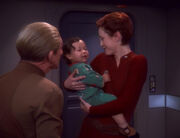
" He knows me. I had him inside of me for five months. "
In Captain Sisko 's ready room , Kira holds Kirayoshi and feels that the infant knows her intimately, given that Kira carried him to term for five months. Kira tells Odo , who is sitting nearby, that she might want to have children of her own someday. Odo, visibly uncomfortable, changes the subject and informs Kira that he has learned from the Bajoran Archaeological Institute that, as Bajoran settlers only arrived on Golana less than a century ago, wherever or whenever Molly is, she's going to be all alone. Soon the crew makes a plan to open the portal and try to lock on to Molly's DNA to beam her back. Although the plan initially works, to everyone's surprise the Molly that materializes in front of them is ten years older. She becomes frightened and bites O'Brien and starts to run wild before Bashir sedates her with a hypospray as her parents watch horrified.
Act Two [ ]
In sickbay on the Defiant , Bashir confirms through medical scans that the DNA matches and the girl they have is indeed Molly. Miles wants to try again, to get young Molly back. Bashir points out that if they do, the 18-year-old Molly will disappear. Keiko says this girl is their Molly; even if they haven't spent the last ten years with her, they don't have the right to take those years away from her. Bashir says it will not be easy for her to re-assimilate; she may even have blocked out all memories of her early life to cope with her prolonged isolation. He believes time with the O'Briens will be her best hope for recovering. They plan to return to Deep Space 9 where a cargo bay is being converted to provide a safe environment for her. Bashir says they'll just have to "feel their way through" her recovery process.
Back on the station, Worf returns to his and Dax's quarters and is surprised to find that she has offered to watch Yoshi while Miles and Keiko spend time with Molly. Worf recalls that Dax has been eagerly waiting to run spectral scans on a comet that will pass through the Denorios belt that night, but Dax tells him that she's decided to miss it because if she leaves there would be no one to watch Yoshi. Suddenly eager to prove himself, Worf offers to watch the baby so she can work her shift. Dax mentions that she has had nine children (five as a mother, four as a father). She's not sure Worf understands how much work babies are, since he did not begin caring for his own son until Alexander was 4. Worf says they will be fine and tells Dax to go to work, only for Yoshi to start crying as soon as she leaves leaving the Klingon trying to settle him down.
Molly wakes up in a grassy area which has been set up in the middle of the cargo bay. When the O'Briens enter, she appears to find them oddly familiar, but has to crouch low to the floor and look upwards at them, to which Miles realizes that from her viewpoint, she remembers them being much taller than her. She becomes skittish and climbs the tree in the grassy area. Miles shows her a plate of fruit from Golana and tries to tempt her. Wary, she comes down and begins eating at a distance from them. Molly tries saying "mommy", but is still afraid. Keiko shows Molly her doll, Lupi . Molly takes the doll and stares at it intently.
Act Three [ ]
As time passes, the O'Briens continue working with Molly on language skills and socialization. They try playing games with balls. Molly likes the balls, but each time Miles tosses one to her, instead of tossing it back, she takes it and hoards it. Finally, they achieve a breakthrough when Molly is just about to hide another ball and Miles says, " Please " and she rolls the ball back to him. All three O'Briens smile.
In Worf and Dax's quarters, the couple are trying to sleep, but Yoshi is crying continuously. Worf complains that nothing he does helps Yoshi fall asleep. Dax offers to take over, but Worf makes an impassioned speech saying that after all he has accomplished in his life and career, he will succeed in helping a crying baby to sleep. Dax asks him why " this babysitting thing is so important all of a sudden? " Worf replies that Dax is judging him on his fitness to parent her future children. He tells her to go back to sleep, " I have work to do. "
In the cargo bay, Molly is asleep in the tree and O'Brien is asleep on a nearby couch. Keiko enters and says Dax has agreed to watch Yoshi so Miles can get some work done. While she is sitting next to O'Brien on the couch, Keiko begins brushing her hair. Molly wakes and watched her, then comes close, hand out for the brush. Keiko starts to give her the brush, but Molly leaves Keiko's hand on it and kneels down, pushing Keiko's hand to brush Molly's hair as she used to do when Molly was little.
As O'Brien and Bashir walk through a corridor, Bashir asks several questions about Molly. O'Brien says she's not talking yet, but she clearly understands what they're saying to her and responds to her name. More and more she reminds him of the little girl she used to be. He shows Bashir a picture she drew and says she's started to eat with a spoon. Bashir mentions how Molly has " anthropomorphized the environment" and cautions O'Brien against pushing her too hard, but O'Brien says she's doing great on her own.
They reach the O'Brien quarters, where Worf is seated on the floor speaking Klingon to Yoshi and playing with a rattle. Worf is saying, " gung, gung, gung " and Yoshi is laughing. Worf explains that he was instructing Yoshi in a Klingon hand eye exercise designed to build a foundation for future warriors. Bashir is amused. O'Brien asks seriously how Yoshi did in the exercise, and Worf says, " He acquitted himself well. "
When O'Brien returns to the cargo bay, Molly is in a panic, grunting and running from one side to the other. Keiko says she has been like this for over an hour. Keiko has to leave to pick up Yoshi and take him home… upon which Molly has another language breakthrough, saying her first actual word since being rescued as she repeats " Home, " clearly understanding its meaning as well as saying her name. The O'Briens are delighted, responding yes, they will take her home. They take her to their quarters. Molly looks around timidly, responding to the "starry stars" outside the view port. But when they take her to her room she becomes agitated. She grabs a picture of them all on a picnic, and keeps saying " Molly home. " The O'Briens realize that to her 'home' is Golana. The planet is off-limits, but Miles realizes there is a way to take her there.
Miles and Keiko decide to take Molly to a holosuite which is simulating Golana to cheer her up and the idea proves to be a good one. Molly calls them "mommy" and "daddy" and begins doing cartwheels as she did on their picnic. Miles thinks they can probably schedule the holosuite for an hour or two every day, as Molly continues to play happily. Then a call comes in from Quark , as a couple of Klingons have reserved the holosuite for some " afternoon carnage " and refuse Miles' offer to reimburse their time. Quark apologizes to the O'Briens as there's nothing more he can do, but Miles says he understands and thanks him for being so accommodating. Miles tries to tell Molly the bad news, but when she completely ignores him, he is forced to end the program. The planet disappears, and Molly is stunned to find herself now in the small, confined room but the confusion soon gives way to anger, and Molly leaves the holosuite in a feral rage, and starts to tear Quark's apart.
After assaulting a few people, a Markalian named Madrat approaches her, to which she responds by stabbing him in the gut with a broken bottle. Just then, Odo and his deputies arrive and stun Molly, but the damage is done.
Act Four [ ]
The Markalian survives but presses assault with a deadly weapon charges. Captain Sisko tells O'Brien that the Federation magistrate has decided that Molly should be taken to a special care center on Dalvos Prime for evaluation; O'Brien is certain they'll end up keeping her there. O'Brien argues that Molly needs to stay with their family to make progress. Sisko tells the chief that he's sorry as there's no other way.
Down in the holding cell, as Molly paces, Bashir reports that her body is flooded with adrenaline due to her confinement, and that there's a risk of her going into shock . Molly then notices her parents and starts to continually throw herself into the force field to reach her father, regardless of the pain. The deputy is forced to turn the force field off, after which Molly starts to get wild again and is sedated. Bashir gives Miles a simple fact; Molly needs open spaces all the time. Bashir will recommend she be put into a holosuite for the time being, but this is just a short-term solution as eventually they'll have to put her on a transport.
In Worf's quarters, Dax arrives to find Bashir has just finished examining Yoshi, who has fallen and has a small bump on his head. The doctor assures Dax and Worf that it's nothing serious and that it happens all the time with toddlers. He leaves to return to the infirmary . Worf explains to Dax what happened. He had been pretending to be a beast and chased Yoshi. The baby was laughing so hard he didn't look where he was going and fell against the table. Worf berates himself for playing too rough, but Dax says it was just an accident. Worf says Dax was right to question his fitness as a father; Dax protests she never said anything like that. He says he failed Alexander, he failed Yoshi, and he would have failed their children as well. Depressed, Worf leaves.
Later, the O'Briens debate what to do, knowing Molly will never cope at a special care center. Keiko realizes Miles is up to something, and he finally admits he is planning to steal a runabout and take Molly back to Golana. Keiko says that's the first place they'll look for her, but then realizes he also plans to send her back through the portal. He says he'll destroy the portal after they send her through. He wishes there were some other way, but he believes she can survive there and be happy. Keiko reluctantly agrees.
Miles goes to security, where Molly is sedated in a holding cell. The deputy tells him Bashir plans to move her to a holosuite before she wakes up. Miles tells him plans have changed, there are no holosuites available and Odo wants her moved to the cargo bay instead. The deputy says he wasn't notified of any change. Miles tells him to check the log and then when the deputy turns away, sedates him.
Miles takes Molly to a runabout, where Keiko has everything prepared. Before they can board, security officer Lieutenant Jones finds them and calls Odo.
Act Five [ ]
Molly is still asleep. Odo sends Jones to go check on the deputy Pinar that Miles sedated and take a statement. The O'Briens beg Odo for help, saying Molly will die if she's returned to the holding cell. Odo says he's very disappointed… because he thought that if anyone could break a prisoner out of a cell and get them off the station it would be Miles. He then opens the door and tells them to get on their way. Keiko hugs him. Odo watches as they board.
In the cavern, Keiko has packed a bag with a knife, a blanket, and Molly's doll. O'Brien reactivates the portal, and Molly smiles. Her parents, happy she's going to survive but still devastated that they're losing their daughter, hug her and then tell her to go home. Molly looks up and says that the stars are the O'Briens' home. They tell her they will be watching her from the stars. She says " Molly loves you " and goes through the portal, holding the bag Keiko gave her. Miles draws his phaser and prepares to destroy the portal.
Once Molly is through, she is about to continue on her way when she hears a little girl crying… and looking around, she finds her eight-year-old self from the present, just minutes after she'd originally fallen through the portal. Older Molly takes her by the hand and tells her " Mommy, Daddy, there, " pointing to the portal. She gives present Molly the doll from the bag, and urges her through. Then she smiles and says, " Molly, home " and disappears as her younger self returns to her own time. A moment before Miles fires his phaser at the device, Molly emerges from the portal and is reunited with her overjoyed parents.
Back on DS9, Worf re-enters his quarters. Dax says it's safe to come in; she dropped Yoshi off at the O'Briens a few minutes ago. She says he was really happy to see his sister. Dax tells Worf they understand the head bump was an accident and they invited Dax and Worf to dinner to thank them for all the babysitting. Worf nervously asks what she replied and she said she told them she'd have to check with him.
Then she asks Worf, " What does 'gung, gung, gung' mean? " She says Yoshi kept shaking his rattle and saying it with great gusto. Worf is pleased. Dax tells him he obviously made a big impression on the toddler. " Maybe you're not as bad with children as you thought, " she tells him. Worf says not as bad as she thought, and she admits that she had doubts but has never been so glad to be proven wrong and they hug. Worf says they had better get to dinner with the O'Briens.
Later that night, Keiko and Miles are talking while Molly is drawing a picture. Miles says Captain Sisko is going to represent him at the Starfleet inquiry, and Keiko says if anyone can make them understand, Sisko can. Molly asks if she can see the girl who found her again. Keiko says not for a while. Miles says Dax explained the recalibration didn't hold, which is why older Molly ended up going through to the same point in time. Keiko wonders if she realized the little girl was herself. Miles says he hopes so.
Molly shows them her picture; it is strikingly similar to the one older Molly drew. Molly says it's where they had the picnic. The O'Briens are startled, but then tell her it's lovely.
Memorable quotes [ ]
" Oh, bollocks! "
" And what exactly is this infant doing in my home? "
" Baby's first bat'leth?"
" By the way, what does… "gung-gung-gung" mean? " " Why do you ask? " " Well, it was the strangest thing. I was taking Yoshi home, and he kept shaking his rattle and saying gung-gung-gung ! " " He did? " " He seemed to get a big kick out of it. So what does it mean? " " That is between Yoshi and me. "
" I can handle a fourteen month-old child. "
" I am a Klingon warrior and a Starfleet officer. I have piloted starships through Dominion minefields. I have stood in battle against Kelvans twice my size. I courted and won the heart of the magnificent Jadzia Dax. If I can do these things, I can make this child go to sleep. " " Talk about losing perspective. "
" I wonder if she realized that the little girl she was looking at was herself. "
"I'm disappointed in you, chief… If anyone could break a prisoner out of a holding cell and get them off the station I'd have thought it would have been you. On your way."
Background information [ ]
Story and script [ ].
- The working title of this episode was "Out of Time". ( Star Trek: Deep Space Nine Companion (p. 577))
- The basic premise of this episode was originally conceived by Joe Menosky for Star Trek: The Next Generation as a way to write Alexander Rozhenko out of the series (as René Echevarria explains it, Menosky came up with the story " as a way to get rid of Alexander, who he really disliked! "). In the original story , Worf and Alexander are on a hunting trip, and Worf loses sight of his son for moment, at which time Alexander falls into a time portal and is retrieved fifteen years later as an embittered Klingon warrior who hates his father for having abandoned him. The episode was never green-lit because Michael Piller was not keen on killing off the character (again, as Echevarria explains, " Alexander was Michael Piller's mother's favorite character! "). ( Star Trek: Deep Space Nine Companion (pp. 577-579)) However, the idea of an older Alexander from the future did form the basis of the episode " Firstborn ". ( Star Trek: The Next Generation Companion (2nd ed., p. 292))
- Although René Echevarria had pitched Menosky's story (with Molly O'Brien instead of Alexander) several times to Ira Steven Behr over the years, Behr had always said no to the episode. Finally, as the sixth season drew to a close, Behr relented, claiming there were three reasons to make the show at the time; " It had been a long time since we'd done a science fiction episode, we'd wanted to do another O'Brien show, and we needed to do something that would be pretty much a bottle show ." ( Star Trek: Deep Space Nine Companion (p. 578))
- In the first draft of Bradley Thompson and David Weddle 's script, Molly spends ten years in another culture, where she is raised in a farming community, by people who treat her really well. When she returns to Deep Space 9 , she is shy and confused, but most of all resentful of her parents, but this idea was scrapped because, as Thompson explains, " It came across as if she had been sent to a bad summer school ." Similarly, Echevarria points out, " It was full of all this teen angst emotional stuff and she sounded so damned American ." ( Star Trek: Deep Space Nine Companion (pp. 578-9))
- Behr came up with the idea to alter the story so that Molly was a feral child . When composing the script, Thompson and Weddle interviewed a number of psychologists and clinical social workers, and much of the behavior exhibited by Molly in the episode is realistic for someone cut off from Human contact from the ages of 8 to 18. For example, her loss of linguistic skills is based on the fact that she's simply forgotten how to speak because she hasn't needed to for ten years, or her tendency to anthropomorphize objects such as trees and rocks, is based upon an innate need, especially in children, for company and companionship. ( Star Trek: Deep Space Nine Companion (p. 579))
- According to the writers, Molly's fear of captivity is based upon a real syndrome suffered by dolphins known as "capture shock"; when a dolphin is trapped, there is a fifty-fifty chance that it will die simply from the act of being trapped – the mere concept of confinement literally kills it. This is why Bashir is so quick to sedate Molly, because he is worried that her reaction to captivity could literally harm her in and of itself. ( Star Trek: Deep Space Nine Companion (p. 579))
- In the original script, there was no B-story in this episode. However, after filming was completed, it became apparent that the A-story was running about nine minutes short. When the producers were trying to conceive of a short B-story, they came to a realization about something: " ' Tears of the Prophets ' represented the last time we would ever see Jadzia Dax , and the last time we'd see the Worf/Jadzia relationship. So we realized that whatever juice we were going to get out of it, we'd better get out of it now ." As things turned out, Behr was especially delighted with the B-story, as he felt it has a great level of poignancy, considering what happens in " Tears of the Prophets "; " It seemed like it'd be nice to show Worf and Dax talking about a future, a future that was never going to be ." ( Star Trek: Deep Space Nine Companion (pp. 580-581))
- The writers considered establishing that the time portals were Iconian in origin, before deciding not to focus on the workings of the portal. ( AOL chat , 1998 )
Production [ ]
- All of the exteriors for this episode were shot in Malibu Creek State Park . During the filming of the picnic scene, Rosalind Chao heard some of the crew whispering during her dialogue, which is an unheard of occurrence; however, she didn't pay any attention and continued on with the scene. After cut had been called, Steve Oster slowly approached the cast and said, " Now Rosalind, don't panic, but… ." As Oster explains, " We were in a big open field shooting the master shot with Keiko and Miles and the two children, when we saw something moving in the grass. It was a rattlesnake working its way towards the shot. We didn't want to alarm the actors and cause a bigger problem. There were two small children there, and we didn't want to freak them out. Allan was unaware of what we were seeing because he was concentrating on the performances, so he didn't call 'Cut'! " Oster and the camera crew quickly discussed what to do (which was the whispering heard by Chao), but decided to play it cool, so as soon as Kroeker did say cut, Oster very calmly asked all the cast to walk slowly towards him, which they did. The snake then proceeded through the shot, closely followed by a park ranger. ( Star Trek: Deep Space Nine Companion (p. 577))
- Jay Chattaway 's composition for the episode included a first for a Star Trek episode with a child's singing voice being used as part of the musical score. ( Star Trek: Deep Space Nine Companion (p. 577))
- Leslie Hoffman was Hana Hatae ’s stunt safety on the beginning of the swing, holding on to her hands just before the camera rolled. Tom Morga was her safety at the end of the swing, catching her.
- Doug Drexler designed a book cover which included illustrations of several aliens from Star Trek: The Original Series : a Kalar , a tree bearing Kaferian apples , a pair of Ornithoids , Ruk , an Andorian , a Mugato , the Talosian known as The Keeper , a Tellarite , a Vulcan diplomat, a pair of the copper-skinned aliens from TOS : " Journey to Babel ", a brown-skinned alien from “Journey to Babel”, and a Gorn . ( Star Trek: Deep Space Nine Companion (p. 579))
Reception [ ]
- Hana Hatae commented: " ["Time's Orphan"]… was so much fun to film. The outdoor scene was filmed at Malibu Creek, which is one of my favorite places to hike and explore. My family and I used to go there all the time when I was growing up. There was a rattlesnake in the bushes right next to where we were filming, so we had to take a break until the park rangers came and removed the snake. The next scene, where I'm falling into the time portal, was awesome to film because I was strapped to a harness and got to swing in front of a green screen. It was pretty much like my own personal little roller coaster ". [1]
- In one scene, after a piece of equipment in the background explodes, Chief O'Brien shouts " Bollocks "; this is an Irish and British expletive referring to the testicles . When the episode was first screened by the BBC in the United Kingdom the word was removed; however, when RTÉ screened the episode in Ireland ( citation needed • edit ) it was left on the soundtrack. Syfy also cut the word when rebroadcasting in the UK in 2014.
Continuity [ ]
- Molly mentions to Yoshi that "last time they went to Golana" he was unborn and being carried by Keiko. Since Miles appeared in every episode depicting Keiko's pregnancy (before Yoshi was moved to Kira's womb), this trip must have occurred in between episodes, possibly even before Keiko announced her pregnancy.
- The console Chief O'Brien uses to operate the time portal is a re-use of the console he and Dr. Bashir used to deactivate the Harvester bio-weapons from the second season episode " Armageddon Game ". It also bears a vague similarity to the TARDIS console from Doctor Who .
- This is the second time that the show has shown someone being erased from time as a result of their past being altered in order to save an individual. This had previously occurred in " Children of Time ".
- Also in " Children of Time ", O'Brien mentions that he's building a dollhouse for Molly. In this episode, Chester is seen lounging on the roof of the dollhouse in Molly's room.
- This is the second time that Miles and Keiko have to deal with the difference in Keiko's and Molly's respective biological ages being narrowed. The first time, Keiko was physically transformed into a child by a transporter accident in TNG : " Rascals ", though she retained her adult memories and mental faculties.
- This episode marks the second and final appearance of Chester , Miles' cat, which was given to him by Liam Bilby in the episode " Honor Among Thieves ".
- Odo says he believed that if anyone could break a prisoner out of a cell and get them off the station it would be O'Brien. This may have been a reference of when O'Brien assisted Tosk in escaping and evading the Hunters in " Captive Pursuit ".
Video and DVD releases [ ]
- UK VHS release (two-episode tapes, CIC Video ): Volume 6.12, 7 December 1998
- As part of the DS9 Season 6 DVD collection
Links and references [ ]
Starring [ ].
- Avery Brooks as Captain Sisko
Also starring [ ]
- Rene Auberjonois as Odo
- Michael Dorn as Lieutenant Commander Worf
- Terry Farrell as Lieutenant Commander Dax
- Colm Meaney as Chief O'Brien
- Armin Shimerman as Quark
- Alexander Siddig as Doctor Bashir
- Nana Visitor as Major Kira
Guest stars [ ]
- Rosalind Chao as Keiko O'Brien
- Michelle Krusiec as adult Molly O'Brien
- Hana Hatae as Molly O'Brien
Co-stars [ ]
- Shaun Bieniek as Deputy
- Randy James as Security
Uncredited co-stars [ ]
- Ivy Borg as Rita Tannenbaum
- Clara Bravo as Kirayoshi O'Brien
- Uriah Carr as civilian
- Cathy DeBuono as M'Pella
- Kathleen Demor as operations officer
- Dorothy Hack as Bajoran woman
- Leslie Hoffman as bar patron
- Irving Lewis as bar patron
- Dennis Madalone as Bajoran man
- Linda Madalone as Bajoran woman
- Mary Mascari as Bajoran woman
- Angus McClellan as operations ensign
- Tom Morga as Madrat
- Mark Allen Shepherd as Morn
- William Steinfeldt as Bajoran ops officer
- Chester E. Tripp III as bar patron
- Alien with sagittal crest
- Reptilian alien
Stunt double [ ]
- Simone Boisseree as stunt double for Michelle Krusiec
References [ ]
4th century ; 2368 ; 2074 ; 2084 ; adrenaline ; afternoon ; air ; airlock ; animal ; anthropomorphize ; archaeologist ; assault with a deadly weapon ; babysitter ; ball ; Bajorans ; Bajoran Archaeological Institute ; bat'leth ; blanket ; bollocks ; bracelet ; cargo bay ; cartwheel ; Chester ; children ; chroniton ; colonist ; comet ; Constable ; courted ; daughter ; Defiant , USS ; Defiant -class ; Dalvos Prime ; Denorios belt ; diaper ; dinner ; DNA ; DNA acquisition sensor ; DNA sequence ; Dominion ; drawing ; drink ; eating ; exobiologist ; father ; Federation ; Federation magistrate ; forehead ; Golana ( moons ); Golana melon ; Golanan ; grint hound ; hairbrush ; hand-eye coordination ; hearing ; heart ; hehh-duHpp ; Hey! Hey! Little Ship! ; holding cell ; holosuite ; husband ; infant ; infirmary ; jumper ; Kelvan ; kiss ; Klingon ; Klingonese ; knife ; language skills ; laughter ; Lupi ; magistrate ; minute ; " Mr. Froggy "; minefield ; month ; mother ; officer ; parent ; picnic ; picnic basket ; pillow ; planet ; power converter ; Quark's ; rattle ; reading ; repair schedule ; Rozhenko, Alexander ; runabout ; sausages ; sedative ; sensor ; sensor range ; shock ; sister ; sleep ; song ; space station ; special care center ; spectral scan ; spoon ; star ; Starfleet ; Starfleet uniform (2370s-early 2380s) ; story ; sunscreen ; sunshine ; table ; Tarkalean ; temporal field ; temporal field generator ; theft ; therapist ; throat ; time portal ; time travel ; transfer ; transport ; transport scanning beam ; tree ; tummy ; warrior ; week ; writing
Unreferenced material [ ]
Child's Garden of Lifeforms in Our Galaxy, A
External links [ ]
- "Time's Orphan" at StarTrek.com
- " Time's Orphan " at Memory Beta , the wiki for licensed Star Trek works
- " Time's Orphan " at Wikipedia
- " "Time's Orphan" " at MissionLogPodcast.com , a Roddenberry Star Trek podcast

IMAGES
VIDEO
COMMENTS
A time portal, or spacetime portal, was a gateway to other times and dimensions. In the 31st century, artificial time portals were utilized by temporal agents in their attempts to protect the time stream from temporal incursions. When Daniels transported Jonathan Archer from the year 2152 to the 31st century to protect him from the Cabal, he inadvertently affected a change in the timeline ...
The Guardian of Forever was a mysterious construct of an unknown, ancient alien race, which functioned as a time portal: a gateway to the time vortex that allowed access to other times, locations and dimensions. It was located on an ancient planet where the focus of all timelines throughout at least the Milky Way Galaxy converged. It was positioned among the eventual ruins of a large ...
Atoz shows them the Atavachron, a time portal. Hearing a woman scream, Kirk runs through the portal, followed by McCoy and Spock. ... They also ranked it the tenth best time travel episode of the Star Trek franchise, including the later 750+ episodes. They note this episode for featuring Spock's travels to an ancient ice age of an alien world ...
After Star Trek: The Motion Picture was released in 1979, but before Harve Bennet took the production reins of the Star Trek films in the early 1980s, Gene Roddenberry pitched a very dark notion for Star Trek II. This concept would have seen the Klingons using the Guardian of Forever to travel back in time and change Earth's past, by preventing JFK from being assassinated.
Kirk, Spock, and McCoy are trapped in a planet's distant pasts, where Spock finds love with an exiled woman. A star shines with a reddish glow, and will soon destroy the planet orbiting it, Sarpeidon, in a supernova. Captain Kirk plans to go with a landing party to warn the inhabitants that their sun (the star Beta Niobe) is about to destroy their planet. Kirk materializes with Doctor McCoy ...
In the Star Trek: Discovery Season 3 episode "Terra Firma Part 2," we learn that the portal Georgiou stepped through in Part 1 was no ordinary door. Yes, it took her to the Mirror Universe, but now, it seems, it will take her to another time — back before the Prime Universes and the Mirror Universes diverged.
Kirk, Spock and McCoy unknowingly step through a time portal that takes them to different points throughout history (All Our Yesterdays)
If you don't remember just who the Guardian of Forever is, the oddly-shaped portal/stone gateway first appeared in one of the most iconic episodes of the original Star Trek: Harlan Ellison's ...
The City on the Edge of Forever: Directed by Joseph Pevney. With William Shatner, Leonard Nimoy, Joan Collins, DeForest Kelley. When a temporarily insane Dr. McCoy accidentally changes history and destroys his time, Kirk and Spock follow him to prevent the disaster, but the price to do so is high.
Franich said that the ending was "one of the all-time great moments in Star Trek history". IGN ranked it as number one out of their "Top 10 Classic Star Trek Episodes" in 2009. ... The episode features the USS Kirk, and has the Guardian projecting a time portal into space, ...
When a drug-crazed Dr. McCoy leaps through a time portal to 1930 Earth, he does something to change history resulting in the disappearance of the Enterprise. Kirk and Spock soon follow hoping to arrive just before McCoy. They soon find themselves working at the 21st Street Mission for the beautiful Edith Keeler.
The 1966-67 TV series The Time Tunnel. In the 1967 Star Trek episode "The City on the Edge of Forever", a temporarily deranged Dr. Leonard McCoy runs into a time portal, an ancient sentient stone-like ring which calls itself the Guardian of Forever, and is transported back to 1930s Depression-era Earth and history is changed as shown when the ...
Premium Rewards. Premium Time Portal for 72 Dilithium. 10x Premium Time Portal for 650 Dilithium. The Premium Portal guarantees every drop to be at least Rare (3 stars). While normally the only way to get pulls from the Premium Portal is by paying dilithium, the monthly reward calendar is also known to give free pulls at the Premium Portal.
© 2024 CBS Studios Inc., Paramount Pictures Corporation, and CBS Interactive Inc., Paramount companies. STAR TREK and related marks are trademarks of CBS Studios Inc.
Time Portals are unstable openings between alternate and parallel dimensions. Through these Time Portals, characters across every time and dimension of the Star Trek Multiverse have converged within Star Trek Timelines. Time Portals--as an item--are single-use and can be purchased for Credits and Dilithium, or obtained from Daily Rewards. "Opening" a Time Portal rewards the Captain with an ...
A time portal[1], also known as temporal portal[2], temporal corridor[3], and temporal gate[4], was a portal for instantaneous movement from one point of the timestream or worldline to another. Traversing a temporal portal was a form of time travel. Temporal portals could be generated artificially, requiring advanced technology to accomplish. (ENT episode: "Stormfront"; STO - Future Proof ...
Here's everything we know about Season 3 of 'Star Trek: Strange New Worlds,' including cast, plot, renewal news and more! We'll add the release date, trailer, guest stars as soon as they're announced.
Harlan Ellison wrote Star Trek's seminal time-travel tragedy, the 1967 episode "The City on the Edge of Forever."For almost six decades, this single story has often been cited as the best ...
Time Portal Update - Elusive Treasures - 2022-06-14. Tomorrow, Tuesday June 14, with our server release we'll update various lootables with previously limited crew, and schematics. Elusive Treasures will also be back, and we'll introduce the Limited Treasures pack, granting 1 behold of 4* or 5* limited (elusive) crew!
The time vortex was the focal point of all timelines. The time portal known as the Guardian of Forever allowed access to the time vortex. Other dimensions and points in time and space could be observed and traveled to through the use of the vortex. (TOS: "The City on the Edge of Forever") The experience of using the Guardian of Forever for time travel was referred to as being in the time ...
Claim one Elusive Treasures 1-pack by completing the relevant temporary achievement. This temporary achievement will be available to all starting on Wednesday, July 28 at 1 am ET (05:00 UTC). Goal to achieve: Start 50 shuttle missions. The achievement will disappear on Wednesday, August 4 at 1 am ET (5 am UTC) at which time you will no longer ...
In Star Trek: Discovery season 3, episode 9, "Terra Firma, Part 1", it was revealed that time soldiers fighting in the Temporal Wars had to contend with a horrific metaphysical affliction.When former Terran Emperor Philippa Georgiou (Michelle Yeoh) began breaking down on a molecular level, Dr. Hugh Culber (Wilson Cruz) sought answers. Federation scientist Dr. Kovich (David Cronenberg) revealed ...
What about Star Trek 4?. Star Trek 4 is still also in development as the final chapter of the Star Trek reboot saga with the Enterprise crew played by Chris Pine, Zoe Saldana, Zachary Quinto, Karl ...
If you think there should be something here, please reach out for support.
Star Trek has been dormant on the big screen for a long time, but the franchise is looking to get back into theaters within the next two years. At CinemaCon, Paramount unveiled its titles for the ...
'Star Trek II: The Wrath of Khan' (1982) Khan's vengeance escalates in this high-stakes entry in the 'Star Trek' series, filled with memorable moments. Follow us and access great exclusive content ...
Related 15 Greatest Star Trek Villains Of All Time, Ranked Just because Star Trek takes place in a mostly idyllic future doesn't mean that its protagonists haven't had to face some menacing foes.
The group included a "Star Trek" art supervisor, Michael Okuda, and his wife, Denise, an artist on "Star Trek" television series and films, and Gary Kerr, a "Trek x-pert" who served as ...
In Star Trek: Discovery season 5, episode 4, "Face the Strange," the villainous Moll (Eve Harlow) and L'ak (Elias Toufexis) smuggled a Krenim Chronophage, or a Time Bug, aboard the USS Discovery. The Time Bug trapped Discovery in a series of loops, sending the starship uncontrollably hurtling through time. However, Captain Burnham and Commander Rayner were able to operate independently in the ...
An accident on the planet Golana sends Molly O'Brien through a time portal three hundred years into the past into an uninhabited world. Beamed back too late, Molly returns to the present eighteen years old with no immediate recollection of her life or her family. Miles O'Brien wakes up with his wife Keiko one morning, happy that both his wife and two children have returned to Deep Space 9 ...